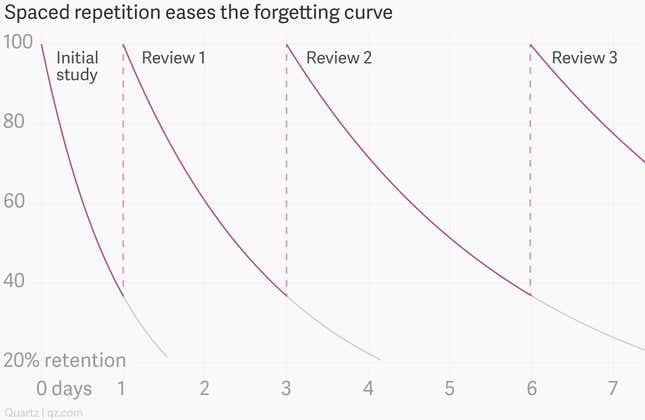Learning has an evolutionary purpose: Among species, individuals that adapt to their environments will succeed. That’s why your brain more easily retains important or surprising information: It takes very little effort to remember that the neighbor’s dog likes to bite. Remembering the dog’s name is harder. One ensures safety, the other is just a random fact.
But today, the kinds of things humans want to learn are rarely focused on survival; we also use our adaptive, evolutionary memory to remember new languages, 11-step face-washing routines, obscure vocabulary words, and facts about Star Wars. The trick to doing so, once you’ve decided to acquire a new skill or build up your knowledge in a particular area, lies in convincing your brain that the information matters. In other words, you have to overcome the “forgetting curve.”
Hermann Ebbinghaus’ memory experiments
The forgetting curve is a mathematical formula that describes the rate at which something is forgotten after it is initially learned. The idea is over 100 years old. It originates in the late 19th century, with German psychologist Hermann Ebbinghaus, who was among the first scientists to perform experiments to understand how memory works.
Ebbinghaus performed his experiments on himself. He would first memorize lists of meaningless syllables, say these:
DIF, LAJ, LEQ, MUV, WYC, DAL, SEN, KEP, NUD
After that, he tested himself periodically, to see how many of the nonsense syllables he remembered at various points in time. Ebbinghaus discovered that his memory of them quickly decayed. This phenomenon of learning and promptly forgetting information will be familiar to anyone who has tried to cram the night before an exam.
Another way of putting it is that the forgetting curve is initially very steep. On a chart, the amount of knowledge retained drops almost straight down. Ebbinghaus also found, though, that his memory eventually leveled off. So the next day, he might remember just a few items from the list—but he would remember those for many days afterward.

Yet if this steep drop-off always followed learning, it seems it would be extremely time consuming to remember any full list. But we know from experience that such forgetfulness doesn’t always occur (Princess Leia’s prison cell block number: AA-23).
Ebbinghaus made a second discovery: The downward slope of the forgetting curve can be softened by repeating the learned information at particular intervals. This principle is the foundation of the learning method known as “spaced repetition,” where material is learned then reviewed after increasingly large time gaps.
The modern version of Ebbinghaus’ discovery is defined with this equation:
R = e^(-t/s)
In this formula, R is a measure of how readily you can recall something, s is the “strength” of your memory, t is the amount of time that has passed, and e is the magical Euler’s number. Repeating and reviewing information increases the strength of the memory, leading the downward slope of R to become more gradual.

Overcoming the forgetting curve is about more than raw repetitions. There has to be space between the reviews. It doesn’t work to just study a new fact 15 times in 1 hour and overcome the curve. If the fact is already at the front of the mind, no work is being done in recalling it again. But if information is repeated at intervals, the brain has to reconstruct that memory, strengthening it like a muscle.
Spaced repetition works on other animals, too. One study trained bees to recognize sugar water from other, less exciting stimuli. The bees that were trained every 10 minutes learned much better than those trained every 30 seconds.
An unhelpful but common metaphor is that of the brain-as-computer, or computer-as-brain. The two things are often presented as working the same way. A brain “stores” memories like files on a hard drive, and software uses “neural networks” to learn like the human mind does. But the reality of learning is different. The computer won’t forget where the file is, and the neural network can only learn what it’s told to.
The forgetting curve shows how brains are different. They can learn anything, which means they need to filter out the important from the trivial. Luckily, understanding how the curve works makes it easier to learn things that may not be necessary for survival, but are deeply rewarding. Like a new language, a musical instrument, or the name of Chewbacca’s father (it’s Attichitcuk).




